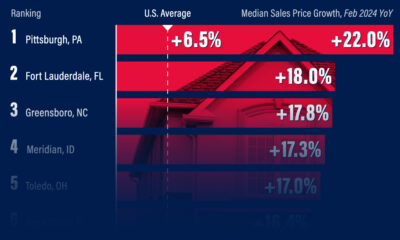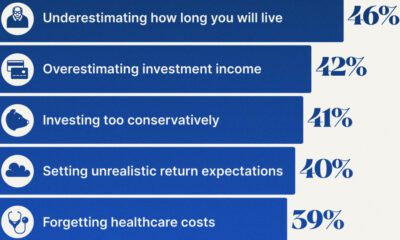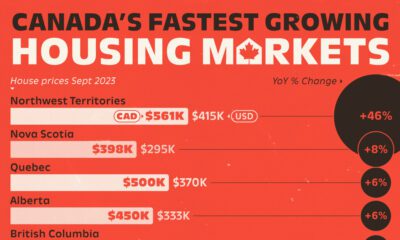Misc
Millennials are Buying Their First Homes, and Here’s What They Want

Millennials are Buying Their First Homes, and Here’s What They Want
Authorities disagree on the exact birth years of the Millennial generation: for example, Pew Research defines Millennials as being born between 1981-1997, the US Census Bureau claims 1982-2000, and the National Association of Realtors says 1980-1995.
However, what all these same sources agree upon is that the Millennials are the largest and most powerful demographic force in North America.
In the United States specifically, Millennials account for a quarter of the entire population with a total of 83.1 million people in the demographic. This is a group that makes up the next generation of investors, continues to struggle with mounting student debt, thinks about money differently, and is now buying homes for the first time.
Marketers in all industries have tried to nail down the preferences of Millennials for some time. Millennials have made things especially more difficult for the real estate industry, as they have delayed common life milestones such as marriage, having children, and home ownership. It is only over the last few years, as Millennials have started to buy homes in significant numbers, that the industry has truly understood what the group wants to see in a home.
Millennial home buyers make up 68% of all first-time home buyers right now, and here’s their average profile: 29 years old, a median income of $76,900, and a typical home purchase (median) of $189,900 for a 1,720 sq. ft home. Of these buyers, 84% believe a home to be a good investment.
Where do Millennials want to buy? About half of the cohort (49%) wants to buy in the suburbs, while 21% would prefer to buy in an urban area. In terms of choosing a specific neighborhood, the most-cited factors affecting Millennials’ decisions were the quality of neighborhood (75%), convenience of getting to job (74%), affordability of home (58%), proximity to friends and family (49%), and quality of the school district (44%).
Today, 32% of all home purchases are made by Millennials, but the reality is that many are still holding off on buying. The major reason for that is student debt, which 54% cited as the biggest obstacle to home ownership. In fact, about one-quarter of all Millennials still live with their parents.
Other reasons cited for not owning a home yet? They include: excessive debt, rising rents, slowing wage growth, tight-lending environment, can’t find home in desired price range, increased college enrollment, and delayed marriage/children.
Original graphic by: UpNest
Misc
How Hard Is It to Get Into an Ivy League School?
We detail the admission rates and average annual cost for Ivy League schools, as well as the median SAT scores required to be accepted.

How Hard Is It to Get Into an Ivy League School?
This was originally posted on our Voronoi app. Download the app for free on iOS or Android and discover incredible data-driven charts from a variety of trusted sources.
Ivy League institutions are renowned worldwide for their academic excellence and long-standing traditions. But how hard is it to get into one of the top universities in the U.S.?
In this graphic, we detail the admission rates and average annual cost for Ivy League schools, as well as the median SAT scores required to be accepted. The data comes from the National Center for Education Statistics and was compiled by 24/7 Wall St.
Note that “average annual cost” represents the net price a student pays after subtracting the average value of grants and/or scholarships received.
Harvard is the Most Selective
The SAT is a standardized test commonly used for college admissions in the United States. It’s taken by high school juniors and seniors to assess their readiness for college-level academic work.
When comparing SAT scores, Harvard and Dartmouth are among the most challenging universities to gain admission to. The median SAT scores for their students are 760 for reading and writing and 790 for math. Still, Harvard has half the admission rate (3.2%) compared to Dartmouth (6.4%).
| School | Admission rate (%) | SAT Score: Reading & Writing | SAT Score: Math | Avg Annual Cost* |
|---|---|---|---|---|
| Harvard University | 3.2 | 760 | 790 | $13,259 |
| Columbia University | 3.9 | 750 | 780 | $12,836 |
| Yale University | 4.6 | 760 | 780 | $16,341 |
| Brown University | 5.1 | 760 | 780 | $26,308 |
| Princeton University | 5.7 | 760 | 780 | $11,080 |
| Dartmouth College | 6.4 | 760 | 790 | $33,023 |
| University of Pennsylvania | 6.5 | 750 | 790 | $14,851 |
| Cornell University | 7.5 | 750 | 780 | $29,011 |
*Costs after receiving federal financial aid.
Additionally, Dartmouth has the highest average annual cost at $33,000. Princeton has the lowest at $11,100.
While student debt has surged in the United States in recent years, hitting $1.73 trillion in 2023, the worth of obtaining a degree from any of the schools listed surpasses mere academics. This is evidenced by the substantial incomes earned by former students.
Harvard grads, for example, have the highest average starting salary in the country, at $91,700.
-

 Real Estate2 weeks ago
Real Estate2 weeks agoVisualizing America’s Shortage of Affordable Homes
-

 Technology1 week ago
Technology1 week agoRanked: Semiconductor Companies by Industry Revenue Share
-

 Money1 week ago
Money1 week agoWhich States Have the Highest Minimum Wage in America?
-

 Real Estate1 week ago
Real Estate1 week agoRanked: The Most Valuable Housing Markets in America
-

 Markets2 weeks ago
Markets2 weeks agoCharted: Big Four Market Share by S&P 500 Audits
-

 AI2 weeks ago
AI2 weeks agoThe Stock Performance of U.S. Chipmakers So Far in 2024
-

 Automotive2 weeks ago
Automotive2 weeks agoAlmost Every EV Stock is Down After Q1 2024
-

 Money2 weeks ago
Money2 weeks agoWhere Does One U.S. Tax Dollar Go?












